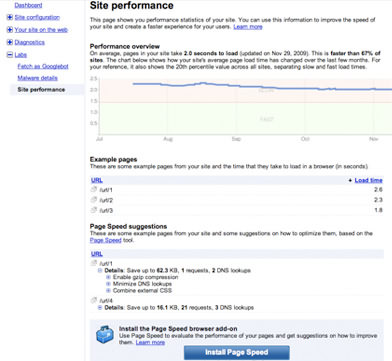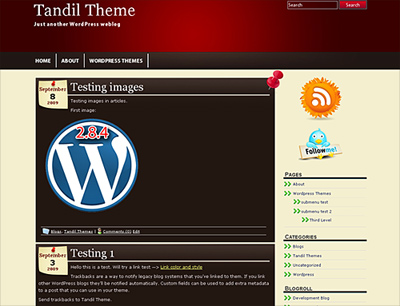When WordPress theme Kubrick was bundled with core back in 2005, it was a cutting edge theme. Custom header, rounded corners, clean design, good coding, fast loading… if you were using WordPress back then, you were impressed with this theme. Time moves on, fashions change, new styles become old standards, and what was once cutting edge suddenly seems old-fashioned and out of date.

The wordpress team believes a new bundled theme in 2010 is a great idea. Something nice and light that can serve as a good example theme, include newer theme-based features, and look nice on a public site. They are going to introduce a new default theme with wp version 3.0, which is anticipated to come out in mid-2010, and think it would be good for it to blend well aesthetically with WordPress itself.
Google’s new goal is to provide internet users with the most relevant results and the best user experience. Fast loading websites increase user satisfaction and improve the overall quality of the internet. If webmasters improve their sites, the overall speed of the web will improve too.

Site Performance
They recently started an initiative known as “Let’s make the web faster” and they released an experimental feature called “Site Performance.” You access this tool from the Google Webmaster Tools dashboard.
WordPress is going to introduce Canonical Plugins very soon. Canonical plugins are plugins that are community developed, which mean multiple developers, not just one person. These plugins will have GPL license and will be available on WordPress.org.

They are planning to keep a very strong relationship between core and these plugins. There will be a screen within the Plugins section of the WordPress admin to feature these canonical plugins as a kind of Editor’s Choice or Verified guarantee. These plugins will be a true extension of core WordPress in terms of compatibility, security and support.
The first rule is simple: don’t copy content from other blogs. It is unethical and Google penalizes duplicate content. Although it will not ban your site from its results forever, Google will send the guilty entry to the supplemental results. Once you are there, it is difficult to come out. The whole purpose of SEO is to optimize a site to rank naturally in the organic search engine results for relevant terms and relevant content.

So please don’t copy! You should create your own unique content. I’m talking about original articles written by yourself. Of course you can grab some ideas from other sites, but make sure you don’t copy-paste the articles or you will be in trouble and your site will get penalized by most search engines.
It is strongly recommended that you backup your WordPress database at regular intervals and before an upgrade. Creating backups of your blog is very easy. You can do it directly from your WordPress Dashboard. You know you should do it regularly, but usually other activities get in the middle and you just forget about it.

The consequences of not backing up your blog are much more serious than you can imagine. If there is any problem with your server or your site’s hard disk fails, or your website get hacked, you will lose extremely valuable data. Although you can have an automatic backup service included in your hosting plan, many times they don’t save MySQL databases. So, to make sure you save your data, you can do the backup manually.
The most common way that search engine robots find and spider a Blog is by following hyperlinks from other sites. In search engine terminology, these sites are known as
“found pages”. Some search engines also have a “submit URL” form, where you can suggest that they add your Blog to their index. Typically, you just give the primary URL for your site (like http://www.tandiltheme.com), and this address is added to their list of links to check and crawl.

There are some services that let you submit your site “automatically”. Currently, there are only four “major” search engines, and you can’t even submit to all of them. 95% of your search engine traffic will come from one of these major search engines. This is not really a good deal, even if it’s free. The same applies to software that submits your site to “thousands” of search engines. As I’ve just stated, only a few search engines actually matter. Using this software is more likely to generate a flood of junk email than anything else, so stay away of it.
When you tweak your Blog, there are some basic rules that apply to designing your pages to be “search engine friendly”. Keep these rules in mind as you build your site, or you could be in for a lot of headaches and problems. All these rules have to do with creating a Blog that search engine bots and spiders can navigate and read easily. If you have no option, but to “break” one of these rules, you’ll need to sort out the details of making your content accessible to the search engines.

First Rule: Try to Avoid Frames.
Search engines don’t handle frames very well, so you’re better off avoiding the use of frames. If you must use them, simply create a “NOFRAMES” version of
your Blog that links all of your content together. But the best option is to avoid frames.
Second Rule: Flash, QuickTime, Add-ons, etc.
Search engine spiders actually can read and index Flash web sites. The problem is that they can’t really trust what they find in the Flash files, because there’s no easy way
to determine which text is visible. Designing your entire site in Flash is crazy from a usability standpoint. This doesn’t mean that you can’t use Flash, QuickTime, or other plug-ins selectively on your HTML web pages. You can. There are a lot of cool things you can do with embedded audio and video, or with the interactive elements that Flash can create. Just because search engines don’t see it, that doesn’t mean you can’t use it, but be picky and selective if you want to use those elements.
When you do some research to rank your sites better in Search Engines, you should be careful where you get your advice from. I recently met a guy at a conference, who thinks that he’s getting special treatment from Google because he inserted the Google search box on his web site. He was planning to publish an e-book, with all his “secrets about SEO”. He has a very nice site with an active blog, which is always getting new inbound links from other Blogs, but that was just an afterthought to him.

If you believe that there’s some top secret about SEO that the “insiders” are not telling you, you are experiencing normal healthy paranoia. Good for you, since your ancestors were the same way, and sometimes it helped them survive. Back in the Stone Age, if one of your caveman buddies drank some yellow water from the hot springs, and got sick, everyone stayed away from it. The ability to learn is a big part of why we’re all still here trying to improve day after day.
The concept of “User Feedback” is very important for a Blog. Most Search Engines have some notion of “user experience” in their rankings. This can be as simple as measuring whether a surfer who clicks a link on search results returns to look at another result. Also all search engines have ways of measuring or estimating the overall user satisfaction with your Blog. How much of a factor this is today, we don’t know, but you can bet that it will become more important over time.

By designing our sites for human visitors and “surfer friendly”, not just for spiders, we are protecting ourselves against any negative impact from user feedback. This is a very important part of the “fast start” system, and always has been. Take this point into consideration when you build your Blog. You can also use the WordPress Tandil Theme to make this even easier. This theme was coded to make your blog surfer friendly.
Hello everyone! I just updated Tandil WordPress Theme today! I made some improvements in the Cascading Style Sheet (CSS). To stay tuned about future Theme Updates you can Follow Us on Twitter or Subscribe to the RSS Feed. You can also leave a comment if you have any questions.
